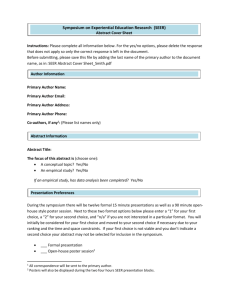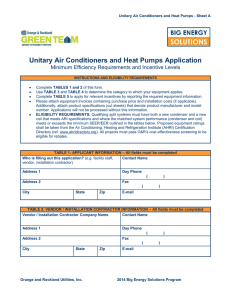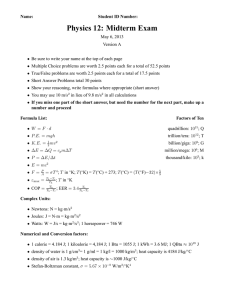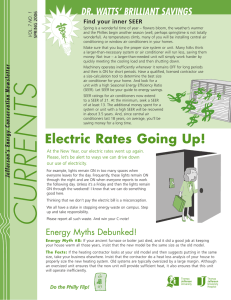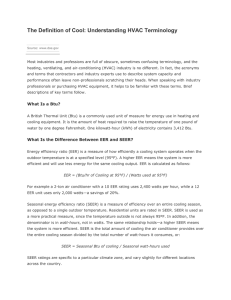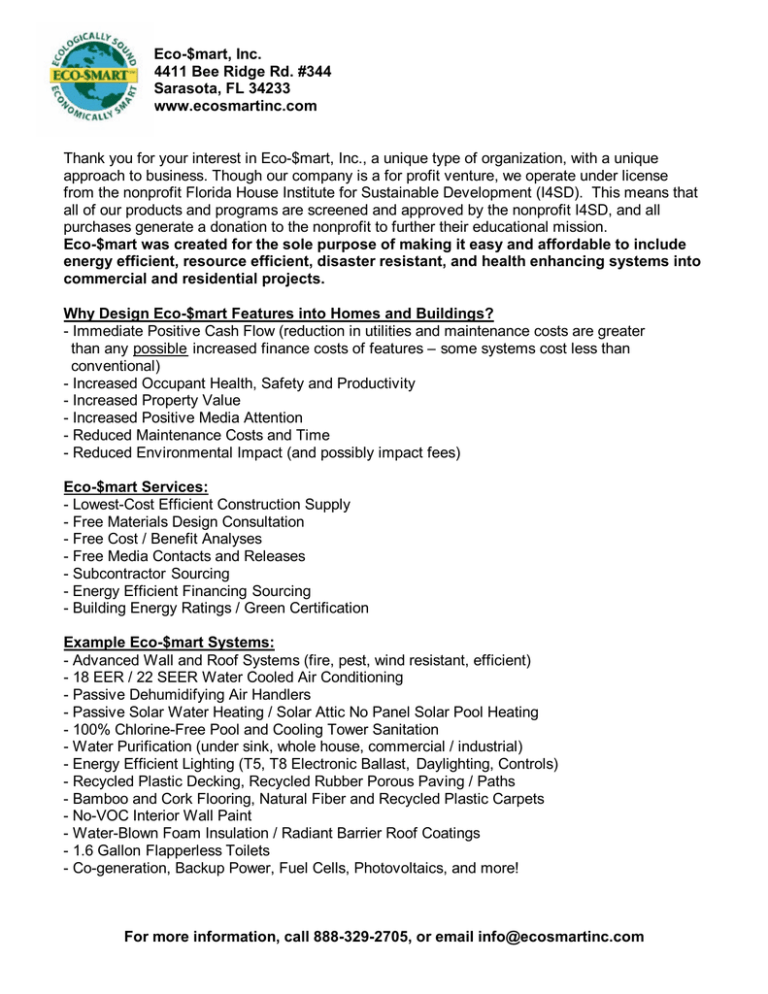
Eco-$mart, Inc.
4411 Bee Ridge Rd. #344
Sarasota, FL 34233
www.ecosmartinc.com
Thank you for your interest in Eco-$mart, Inc., a unique type of organization, with a unique
approach to business. Though our company is a for profit venture, we operate under license
from the nonprofit Florida House Institute for Sustainable Development (I4SD). This means that
all of our products and programs are screened and approved by the nonprofit I4SD, and all
purchases generate a donation to the nonprofit to further their educational mission.
Eco-$mart was created for the sole purpose of making it easy and affordable to include
energy efficient, resource efficient, disaster resistant, and health enhancing systems into
commercial and residential projects.
Why Design Eco-$mart Features into Homes and Buildings?
- Immediate Positive Cash Flow (reduction in utilities and maintenance costs are greater
than any possible increased finance costs of features – some systems cost less than
conventional)
- Increased Occupant Health, Safety and Productivity
- Increased Property Value
- Increased Positive Media Attention
- Reduced Maintenance Costs and Time
- Reduced Environmental Impact (and possibly impact fees)
Eco-$mart Services:
- Lowest-Cost Efficient Construction Supply
- Free Materials Design Consultation
- Free Cost / Benefit Analyses
- Free Media Contacts and Releases
- Subcontractor Sourcing
- Energy Efficient Financing Sourcing
- Building Energy Ratings / Green Certification
Example Eco-$mart Systems:
- Advanced Wall and Roof Systems (fire, pest, wind resistant, efficient)
- 18 EER / 22 SEER Water Cooled Air Conditioning
- Passive Dehumidifying Air Handlers
- Passive Solar Water Heating / Solar Attic No Panel Solar Pool Heating
- 100% Chlorine-Free Pool and Cooling Tower Sanitation
- Water Purification (under sink, whole house, commercial / industrial)
- Energy Efficient Lighting (T5, T8 Electronic Ballast, Daylighting, Controls)
- Recycled Plastic Decking, Recycled Rubber Porous Paving / Paths
- Bamboo and Cork Flooring, Natural Fiber and Recycled Plastic Carpets
- No-VOC Interior Wall Paint
- Water-Blown Foam Insulation / Radiant Barrier Roof Coatings
- 1.6 Gallon Flapperless Toilets
- Co-generation, Backup Power, Fuel Cells, Photovoltaics, and more!
For more information, call 888-329-2705, or email info@ecosmartinc.com
High Efficiency / Healthy Indoor Air Quality
Air Conditioning Package
System Components:
18 EER / 22 SEER Freus Water Cooled Condensing Unit – Reduces energy consumption
from air conditioning by 50 to 60 percent versus 10 SEER (standard) condenser. More efficient
than 20 SEER air-cooled equipment. Fiberglass cabinet, 15 year limited warranty.
Heat Pipe Passive Dehumidification Air Handler – By passively pre-cooling and post-heating
the air moving across the evaporator, your air conditioner becomes twice as powerful in
dehumidification. Mold in ducts and wallboard is avoided and higher temperatures feel more
comfortable, saving more a/c costs.
Intelligent Fan Recycler Fresh Air Controller – Installed with a 4”duct
from outside air to the return of the air handler. Cycles the air hander on
every 30 minutes to create more fresh air exchanges and positive
pressure on the home, flushing toxins out and keeping humidity from
being drawn in through air infiltration. We also recommend installing a
humidistat in parallel with the thermostat, set to turn on the HVAC system
any time the humidity level goes over 55%.
Eco-$mart, Inc: 888-329-2705 ~ 941-377-9460 ~ www.ecosmartinc.com
All Eco-$mart products are approved by the nonprofit Florida House Institute for Sustainable Development
NEWS RELEASE
For Immediate Release
Contact: Matt Ross
Phone: (941) 377-9460
World’s Most Energy Efficient Air Conditioner Comes to Florida
Introductory Seminar at Florida House October 5th
Sarasota, FL, September 25, 2002: The Freus, the world’s most energy efficient air
conditioning condensing unit, is now available in Florida. Home and business owners
can see a Freus unit in operation and learn more at an introductory seminar at 11:00
A.M., Saturday, October 5th at the Florida House Learning Center, 4600 Beneva Rd.
South, in Sarasota. Local air conditioning contractors handling the Freus will be in
attendance to answer questions, as well. The Freus is distributed in Florida by Eco$mart, Inc., the for-profit distribution company operated in partnership with the nonprofit
Florida House Institute for Sustainable Development. All Eco-$mart products are
screened and approved by the nonprofit Florida House Institute.
The Freus was recently rated by the Air Conditioning and Refrigeration Institute (ARI) at
a 16 EER, saving 50 to 60 percent on air conditioning bills versus standard air
conditioners. This super high efficiency is achieved because Freus is a water-cooled
condenser, versus standard equipment that is air-cooled. The water in the Freus is
contained in a sump in the bottom, which cools the standard refrigerant coming out of
standard interior cooling equipment. The water is then pumped up to the center of the
Freus, which contains its own internal PVC cooling tower.
Water-cooled air conditioners can only be rated with an EER versus a SEER for aircooled equipment. EER testing is done at 95 degrees outside air temperature and high
humidity, where SEER testing is done at 82 degrees outside air temperature and
moderate humidity. The most energy efficient (18 SEER) air-cooled equipment
achieves only a 10 to 13 EER, compared to Freus’s 14 to 16 EER. This means that on
hot, humid Florida summer days, the Freus is 20 to 25 percent more efficient than the
best air-cooled units.
The Freus is not only very energy efficient, it also is designed to last longer than
standard air conditioners. The cabinet of the Freus is all fiberglass, and the condensing
coils are constantly washed with water, protecting the unit from salt air corrosion that
degrades standard equipment. The Freus uses the industry’s most reliable, Copeland
scroll compressor, which operates at lower temperatures and pressures due to the
lower condensing temperatures achieved by the water – this means longer compressor
life. In addition, the Freus contains no electronic circuitry to fail, unlike high efficiency
air-cooled equipment. The Freus is also reasonably priced, making it a very attractive
upgrade option with a short payback period for home and business owners.
For more information, please contact Matt Ross, Eco-$mart, Inc. at (941) 377-9460.
###
How Much Can You Save by Switching to a Freus, the
World’s Most Energy Efficient Air Conditioner?
Freus 18 EER Water-Cooled Condensing Unit – The most energy efficient condensing
unit on the market. By using water to cool refrigerant, then using a built-in cooling tower to
cool the water, the Freus is efficient, quiet and low maintenance. The Freus also maintains
its cooling capacity on the hottest, most humid days of the year much better than
conventional air-cooled condensers. 15 year limited warranty is standard. (Note: EER testing
is don at 95 degrees, where SEER testing is done at 82 degrees. The 18 EER is equivalent to
over 22 SEER).
Projected Utility Cost Savings – Central Florida*
Freus
Freus
Efficiency Vs:
Ann. Savings
20 Yr. Savings
10 SEER
$831.00
$16,620.00
12 SEER
$554.00
$11,080.00
14 SEER
$312.00
$6,240.00
Other Freus Benefits:
- Quieter Operation
- Longer Life and Lower Maintenance Due to:
Lower Pressures
Lower Operating Temperatures
Fiberglass Cabine t
Condensing Coils Protected from Salt Air by Water
No Electronic Circuitry
- Excellent Dehumidification (smaller compressor, more even cycle times)
*Utility costs and savings are based upon a 3-ton unit, operating 2800 annual hours at $0.09
per kWh using actual historical weather data from Orlando, Florida and performance ratings
issued by the American Refrigeration Institute, the National standards organization for air
conditioning. Detailed calculations are available upon request. The chart above assumes no
annual increase in utility costs. Note: for heat pump users switching to straight cool, reduce
savings by $75 per year. Typical water costs for Freus are between $20 and $25 per year.
All systems have been approved by the nonprofit Florida House Institute for Sustainable
Development, creators of the Florida House Learning Center in Sarasota, FL. A portion of all
proceeds from purchases of these systems is donated to the nonprofit Florida House Institute to
support their environmental education and facilitation mission. See www.i4sd.org for more
information about Florida House efforts. For more information on Freus, contact Eco-$mart, Inc at
888-329-2705 or www.ecosmartinc.com.
Freus Equivalent SEER Entry for Florida Building Energy Codes
The Freus water cooled condensing unit is not rated with a SEER, only an EER. Both ratios are expressed in BTU-hrs of cooling
per watt-hr of energy used, but the SEER testing is done at 82 degrees drybulb, 65 degrees wetbulb, where the EER testing is
performed at 95 degrees drybulb and 75 degrees wetbulb, a much hotter, more humid outside air condition. EER testing is done on
every air conditioning unit rated by ARI to determine its full load cooling capacity.
According to ARI, since the Freus is water cooled it cannot publish a SEER, only an EER. Below is a table of SEER and EER values
for the top rated air cooled condensing units and the Freus. The DCA, who oversees the energy code software for the State of Florida,
recommends that energy raters use ratios of EER to SEER to calculate the SEER entries into the software, until such time as EER
values are allowed as entries.
Brand
Freus
Carrier Weathermaker Two Speed
Outdoor Model #
10M37
38TDB037300
Indoor Model #
FK4BN006
CK3BA048+58U(H,X)V060-12
Cooling Capacity
(mBtuh @95)
36.0
35.6
EER (@95)
16.0
12.15
SEER (@82)
See Note *
17.0
Trane XL1800
TTZ036A
TWE040E13
38
12.8
18.0
* Note: The Freus clearly performs better at high outside air temperatures than the 17 or 18 SEER air cooled
units. Therefore, by ratio, the entry for the Florida Energy Code software for the Freus should be:
(using Trane 18 SEER data)
or (using Carrier 17 SEER data)
Averaged:
18 / 12.8 = Freus / 16
17 / 12.15 = Freus / 16
Freus = (18 / 12.8) * 16 =
Freus = (17 / 12.15) * 16 =
Freus =
22.50
22.39
22.44
For more information, contact: Eco-$mart, Inc. 888-329-2705 or ecosmart@comcast.net
For more information regarding energy codes, contact: Dept.of Commnnity Affairs: 904-488-8466
The Freus – An Overview
The Freus utilizes a unique, but proven approach to refrigerated air conditioning
condensers. The patented system uses water to cool and condense the refrigerant, enabling the
Freus to provide more consistent, quieter cooling performance, often at only half the energy costs of
conventional “air-cooled” condensing units. Condensing temperatures achieved by the Freus can
be over 20 degrees cooler than conventional equipment, reducing compressor power usage, and
extending the life of mechanical components within the Freus. The Freus uses reliable, time-tested
Copeland Scroll compressors and a simple, durable design to provide unsurpassed efficiency and
long life. The Freus can be used in conjunction with most major manufacturers’air handling
equipment, in retrofit or in new construction.
Frequently Asked Questions
1.
How Does the Freus System Work?
The Freus uses water instead of air to cool the refrigerant to a condensing temperature of around
90 degrees. An equal volume of water absorbs 3,500 times more heat than air. The water is then run
through a PVC cooling tower inside the unit where moving air returns the water to the ideal condensing
temperature. This low condensing temperature allows a smaller compressor to provide more cooling at
half the pressures of air-cooled units. Looking at any manufacturer’s compressor chart, you will quickly
see that all condensers are more efficient at lower condensing temperatures.
2.
Why should a homeowner install a Freus?
The Freus is the most energy efficient unitary air conditioner on the market, reducing air
conditioning costs by 40 to 60 percent versus standard equipment, saving hundreds of dollars a year. The
Freus is also designed for low maintenance, with a fiberglass cabinet, triple thickness coils protected from
salt air, and high pressures in the compressor only half the level of an air-cooled unit. Unlike other high
efficiency condensing units, Freus has no expensive electronics on board to corrode, short or get surged
by lighting. All these features mean longer life with lower maintenance. In addition, the steady
efficiency performance of the Freus at high and low outdoor temperatures creates more even cycle times,
providing for better household dehumidification in humid climates.
3.
How easy is the Freus to install?
The Freus is installed in much the same manner as an air-cooled condenser, on a ground pad or as
a roof-mounted unit. The compressor comes pre-charged with enough R-22 for a 15-foot run. The only
difference in installation is the requirement to connect the ¼” water make up line to a water supply
(connecting hose and splitter for hose bib provided for retrofit).
4.
What about price?
The average Freus will cost about the same as a conventional 14 SEER unit. Due to the steady
capacity, the condenser can be sized flat, not sized larger for hot climates like air-cooled units often are.
This savings in tonnage can offset some of the cost difference between the Freus and air-cooled
condensers. The Freus has the unique ability to service multiple air handlers from one condensing unit.
The cooling tower section provides up to 10 Tons of cooling, so two or three compressors up to 10 total
Tons can be housed in one cabinet. Now homes or offices requiring several units can share a single
condensing unit, reducing equipment costs, and requiring maintenance of fewer units. The Freus will
typically qualify for the highest utility rebates, as well, further reducing initial costs.
5.
How do I determine condenser size when using a Freus?
Freus sizing is somewhat more forgiving than with air-cooled units, as they do not diminish in
cooling performance as outdoor temperatures rise nearly as much as air-cooled units (4% versus up to
25%). However, as with any HVAC system, sizing the Freus system should be done based on the Btu/h of
cooling needed at design conditions. Refer to Freus capacity tables and compare them to air-cooled unit
capacity tables to make comparisons for your local area.
6.
My City Code says I can only use an Evaporative Cooler that is a “Water Conservation
Device”. Does the Freus Qualify?
Yes. The Freus is technically not an “Evaporative Cooler”; it is a water-cooled condensing device.
Many restrictive codes, (i.e. Fresno CA Section 14-201) limit the water consumption to a maximum of 9
gallons per full load hour per ton of capacity. The Freus uses a maximum of 1 gallon per full load hour
per ton of capacity. This water use amount will drop by half, or more, if the condensate water is directed
back into the unit, a procedure that is highly recommended (this makes the Freus even more efficient as
the condensate water cools the Freus sump). One should also consider that the amount of water used to
generate power at the power plant is reduced by much more than the Freus could ever use in performing
its work. Therefore, the Freus qualifies as a “Water Conservation Device”.
7.
The Freus uses water to cool the condenser, so what about the cost of water?
Generally speaking, Freus water cost is approximately $20 per year per 1000 annual run hours.
8.
Where does the water run off go?
To keep the system clean of mineral deposits, the Freus periodically bleeds off water, which is
replaced via a simple float activated valve. This can be run into the garden near the home, into a French
drain, or suitable drain as may be required by local codes.
9.
How does the Freus perform in a hot and humid environment?
EER refers to the BTU’s of cooling per unit of electricity a system provides, tested at 95 degrees
outside air temperature with a 75 degree wet bulb temperature (higher wet bulb is more humid). SEER is
the same test, performed at 82 degrees with a 65 degree wet bulb (less humid). Compare the 15-16 EER
of the Freus to the 12-13 EER for air-cooled 18 SEER equipment. Freus is up to 25 percent more
efficient than the 18 SEER air-cooled units at those higher temperatures and humidity. This is due to the
fact that the water temperature in the Freus stays relatively constant throughout the year, and low
condensing temperature is the key to low energy use. The widespread use of commercial cooling towers
in Florida demonstrates their practicality.
10.
Why is the exhaust from the Freus so much cooler than the exhaust from my old air
conditioner condenser?
First, one must understand that the exhaust air from the Freus is only being drawn across water,
not across a hot condenser coil. When the air moves across the water, heat is drawn out of the air via
evaporation and moisture is added to the air, which will actually lower the air temperature as it crosses the
evaporative media. For this reason, the air temperature coming out of a Freus is up to 20 degrees cooler
than the outside air, as compared to exhaust air from air-cooled units which can be 30 degrees warmer
than the outside air. These cooler temperatures will increase the compressor life, the fan motor, and the
overall life of the Freus.
11.
What is the difference between SEER and EER?
Freus units are rated under ARI standard 210/240-94 along with residential air conditioners
Section 5 of ARI Standard 210/240 specifies that only air units less than 65,000 Btu/h are rated with an
SEER rating (which is tested at 82 deg. db/65 deg. wb ambient) and all other units are rated with an EER
rating (which is tested at 95 deg. db/75 deg. wb ambient). Both ratings are performed with an indoor
condition of 80 deg. db/67 deg. wb, and so the SEER rating performed at a lower ambient condition has a
much higher efficiency number.
Ask yourself – Which testing condition is more like the condition that exists where you live – EER
at 95F or SEER at 82F.
ARI has prohibited us from publishing an equivalent SEER at 82F, but they have allowed us to
make application rating comparisons. Following is a comparison of a Freus, a Carrier, and a Trane unit,
tested under the same conditions, so you can draw your own efficiency conclusions.
Brand
SEER
@ 82
Mbtub @ 95
CD5BXA060
N/A
35.6
CK3BA048+58U(H,
X)V060-12
17
35.6
12.15
18
38
12.8
Outdoor
Model #
Indoor Model #
Freus
10M37
Carrier Weathermaker
Two Speed
38TDB037300
Trane XL1800
TTZ036A
12.
TWE040E13
Capacity
EER
@ 95
16.1
What about freezing temperatures? Will the customer have to do anything to protect the
unit?
A flush and fill kit with freeze protection is available, as an option. This kit automatically drains
the water at low temperatures, and prevents water from coming into the unit. The customer can winterize
by shutting off the water supply and draining the unit, which takes about 5 minutes and no tools.
13.
What compressor do you use and why?
Freus units have Copeland Scroll Compressors. These are installed because they are quiet,
efficient, and reliable. Copeland Scroll Compressors are widely regarded as the premier compressors on
the market today.
14.
Since the Freus is water-cooled, how are Algae, Bacteria, and Legionnaires’disease concerns
addressed?
The primary point of prevention of water-borne disease is the municipal water treatment plant.
Most public water supplies are treated with chlorine to control microbiological contaminants and checked
regularly by public health officials. After decades of research there has never been a single case of water
borne disease linked to an evaporative cooler or residential water-cooled evaporative condenser like a
Freus unit.
Freus engineers have taken care to design the Freus to inhibit the amplification of microorganisms.
Some of the main design features for these purposes are:
1.
The Freus unit is a split system air conditioning condenser, connected to an indoor
section where the water is completely separate from the indoor components, keeping the
water and humidity outdoors.
2.
The sump temperature is kept lower than commercial evaporative condensers to
make bacterial growth more dormant.
3.
The Freus sump is shaded to prevent growth of algae.
4.
The evaporative media is designed to drain water down into the sump, dry out, and
thereby kill aqueous bacteria in the media.
5.
The sump water is exchanged periodically by a bleed off system. This purges the
sump, brings in municipally treated water, and prevents microbiological concentration.
6.
Freus recommends the unit be cleaned during annual servicing.
For these reasons, Freus does not recommend any chemical treatment beyond what the public
water authorities perform.
15.
How do you make water and electricity in the same environment safe?
Freus housing is fiberglass. Electrical elements are isolated. All Freus designs meet or exceed UL
requirements.
16.
Do mineral deposits accumulate on the condenser copper tubing? What about corrosion?
Yes, minerals are left behind as water evaporates and they do get on the condenser coil,
however, they do not accumulate to great enough thickness to measurably reduce the performance of the
Freus. The Freus has been designed to minimize these deposits and avoid corrosion problems with the
following features:
1.
Freus units purge the sump water periodically to prevent heavy concentrations of
minerals from accumulating.
2.
The copper condenser coil has a .032 wall thickness which is far thicker than the
common .012 copper wall thickness used on air cooled condensers, reducing the chance of
corrosion damaging the piping.
3.
The Freus copper condenser coil is continually washed with fresh water during
operation, reducing contact with air, greatly slowing the corrosion process. The entire coil
is also coated with an electrostatically applied commercial coil coating to give added
corrosion resistance.
4.
The intertwined helical copper condenser coil naturally expands and contracts with
temperature changes at a different rate than mineral deposits do. As a natural consequence,
as minerals eventually build up on the coil (to a slight thickness) this expansion and
contraction process tends to break lose the minerals and shed them off.
5.
The Freus is shipped with a sacrificial anode to prevent water scaling and
corrosion, similar to most water heaters on the market.
6.
Freus recommends annual servicing to clean the Freus unit. This includes spraying
out the sump/coil with a water hose to clean out mineral deposits.
For these reasons Freus provides a limited 10 year warranty on the copper condenser coil as part
of its standard limited warranty.
17.
What is the background of the manufacturer of the Freus?
Management of the manufacturer has been involved in the development, sales and servicing of
water-cooled air conditioners for over 25 years. The Freus is the manufacturer’s latest model,
integrating many advancements developed during years of experience with water-cooled, selfcontained condensing units.
Distributed By:
FREUS, Inc.
8240 Donithan Drive
Vinton, TX 79821
888-329-2705
WARRANTY INFORMATION
Cabinet— 15 year limited warranty. If within 15 years, (starting no more than one year after
date of manufacture), any fiberglass cabinet part should prove defective and non-serviceable in
materials or workmanship, return the defective part, freight prepaid, to your Freus dealer for
replacement or repair at factory option. The part will then be shipped at factory expense to
sender.
Condensing Coil Copeland Scroll Compressor— 10 year limited warranty. If within 10 years,
(starting nor more than one year after date of manufacture), the Copeland Scroll Compressor or
the copper condensing coil used in the Freus should prove defective and non-serviceable in
materials or workmanship, return the defective part, freight prepaid, to your Freus dealer for
replacement. The part will then be shipped at factory expense to sender.
All other parts-5 year limited warranty All other parts are covered by a 5 year warranty. If
any part not covered by a 10 or 15 year warranty fail during the first 5 years of use (starting not
more than one year after date of manufacture), return the defective part, freight prepaid, to your
Freus dealer for replacement or repair at factory option. The part will then be shipped at factory
expense to sender.
Freus provides a labor allowance for repairs for the first year. Any additional service or
installation is between dealer and purchaser and not the responsibility of Freus. Freus does not
pay the cost of the service call at the site of installation to diagnose the cause of trouble, the cost
of labor to install the part or remove it (beyond the labor warranty period), or mileage to and from
the installation site.
This warranty is in lieu of any other expressed or implied warranty and all other obligations on the
part of Freus. Freus does not authorize any other person to extend or alter any portion of this
warranty.
This warranty gives purchaser specific legal rights. In addition, purchaser may have other rights
that vary from State to State.
------------------------------------------------------------------------------------------------------------
REGISTRATION CARD
______________________________________
Date of Purchase
___________________________________
Place of Purchase
______________________________________
Freus Model number
___________________________________
Freus Serial Number
________________________________________________________
Name
_________________________________________________________
Address
__________________________________________________________
City
State
Zip Code
File: Freus-Warranty.doc
Date: 12/15/02
Mail
Card
to:to:
MailRegistration
Registration
Card
Freus
FreusInc.
Inc.
Attn:Warranty
Warranty Registration
Attn:
Registration
P.O.
117 Drive
8240 Box
Donithan
Sunland
NM 88063
Vinton, Park,
TX 79821
915-886-9050
TECHNICAL SHEET
Buying an Air Conditioner?
Remember the EER!
w
hen buying a new
home cooling system,
be sure to get the whole
story on its energy efficiency.
Central air conditioners and heat
pumps are rated by the Seasonal
Energy Efficiency Ratio (SEER).
But SEER tells only part of the
energy story. Another rating, the
EER or Energy Efficiency Ratio, is
also important in selecting the best
system. They probably sound
similar but they are different.
Why two efficiency ratings?
Just as your car’s gas mileage is
rated for city and highway
driving conditions, SEER measures
cooling system efficiency at low
temperature (82˚F) while EER
is a high temperature (95˚F)
performance rating.
So what should you do? Ask for an
air conditioner with both
a high SEER (13 or greater) and
a high EER (11 or greater).
This assures you of high
efficiency at the full range of
California summer temperatures.
It’s easier with room air
conditioners: They are tested
only for EER, so just look for a
high number.
ome air conditioners and heat
pumps are more energy-efficient
than others when running on a very
hot day. Others may be superior in
moderately warm temperatures. But
since your air conditioning system
faces both cooling conditions, it needs
to be efficient in both seasonal and
peak day operations.
S
CHECKING THE RATINGS
Two different efficiency ratings
provide the information you need to
choose the best unit. These are the
Seasonal Energy Efficiency Ratio
(SEER) and the Energy Efficiency Ratio
(EER). When buying a new cooling
system, it is important to consider its
energy efficiency under different
operating conditions.
he SEER is shown right on the
system’s yellow Energy Guide
Label and in its published
specifications. To find the EER,
however, you will need to ask your
contractor who can obtain
comprehensive equipment
specifications, including EER, from
the distributor or manufacturer.
Your contractor should know the EER
of the equipment he is proposing to
install because it’s important.
Particularly if you live in a hot climate,
a system with a good SEER but a low
EER probably won’t deliver the energy
savings and cost savings you’re
counting on.
WHAT DO THESE RATINGS TELL YOU?
FINDING A BALANCE OF SEER AND EER
he SEER measures a cooling
system’s average efficiency
throughout the whole cooling season.
This number is based on a national
“standard” cooling load and climate.
Testing for SEER is conducted at an
outdoor temperature of 82˚F. Since
approximately one third of California’s
annual cooling requirement occurs
when temperatures are over 95˚F, air
conditioning performance at high
temperatures is very important. The
EER provides a measure of cooling
system performance at 95˚F. The math
behind it is really quite simple—peak
cooling capacity in Btu/hour divided
by power input in watts. A higher EER,
means you’re getting more cooling
output for every unit of power input.
You may forget the math but make
sure that your new air conditioner or
heat pump has both a high SEER and
high EER.
T
T
ew equipment choices have
many combinations of SEER and
EER ratings. A high SEER rating does
not necessarily mean the system will
also have a high EER, or vice versa.
For example, as shown in the table
below, two air conditioners with the
same SEER have quite different EER
ratings. Due to System B’s higher EER,
N
Performance Ratings for Two
SEER 14 Central Conditioners*
SYSTEM A SYSTEM B
SEER
14
14
EER
10.52
11.37
Cooling Capacity
36,000 Btus 37,800 Btus
Power Consumption 3,420 watts 3,320 watts
* Data from PG&E report, Evaluation of Four High-Efficiency
Residential Split System Air Conditioners, August 2000, p. 2.
it delivers more cooling and has lower
power consumption. In other words,
you get more cooling for less money.
You may notice that the EER is always
smaller than the SEER. This is because
it’s measured under tougher conditions.
Again, the objective is to find a good
combination of relatively high SEER
and EER.
HOW HIGH SHOULD THE RATINGS BE?
ederal law sets minimum SEER
ratings. For central air
conditioners and/or heat pumps, the
minimum SEER is 10. Far more
efficient systems are available, with
SEERs reaching 18 or greater.
An EER of 14 is close to the upper
limit of current technology. It’s usually
best to look for a SEER of at least 13
and an EER no less than 11. It should
be higher on both measures if you live
in a hot climate.
F
When you select a high EER system
you receive more than energy savings,
you also get more cooling when you
need it most. The graph below
compares the cooling capacity of two
three-ton systems at 95˚F. The graph
shows the Btu’s per hour of cooling
delivered by an EER 9.2 system and a
higher efficiency EER 11.4 system.
The higher efficiency system (SEER
14/11.4 EER) provides 18% more
cooling when the outdoor temperature
is 95˚F than the lower EER (SEER
10/EER 9.2) system.
IS A HIGHER EFFICIENCY SYSTEM
WORTH ITS EXTRA COST?
n general, more energy-efficient
systems have higher price tags.
However, lower electricity bills may
amply repay this extra initial
investment. The tradeoff between
energy cost savings and this higher
purchase price depends on a lot of
factors, such as how often you’re
home, where you live, the size and
age of your house, and how its
windows and walls absorb heat, etc.
For example, the following graph
compares the annual estimated cooling
costs for different SEER and EER
systems cooling 2,000 square foot
homes in Stockton and Fresno that are
ten years old.
I
Annual Central Air Conditioning Costs
$1000
$800
$700
$600
$500
FINDING OTHER IMPORTANT
AIR CONDITIONING TIPS
■ Be sure your contractor calculates
your home’s cooling needs and
selects the most appropriate
equipment size. An oversized air
conditioner or heat pump uses more
energy for the same cooling, and
may make more noise, wear out
sooner, and produce annoying
drafts due to turning on and off too
frequently—so you lose all around.
■ Have your ducts tested for leaks,
and sealed if necessary. Leaky ducts
can waste more energy than your
new air conditioner saves…and can
cause other serious problems too.
For more energy efficiency
information, call the Smarter Energy
Line at 1-800-933-9555, or visit
www.pge.com.
$200
$100
FRESNO
2000 sq. ft. Single Family Home
35,000
Btus of Cooling
EER ratings only. The Federal
minimum efficiecy varies by cooling
capacity. Remember, the higher the
EER on the Yellow Energy Guide Label,
the more efficient the air conditioner.
$400
STOCKTON
36,000
nlike central systems, room air
U conditioners are labeled with
■ Hire only licensed air conditioning
contractors who understand the
importance of SEER and EER ratings
and can help you make the best
choices to meet your needs for
comfort and economy.
$900
$300
Comparison of
Two 3-Ton Systems’
Cooling Capacity at 95˚F
WHAT ABOUT ROOM AIR
CONDITIONERS?
Minimum Efficiency, SEER 10/EER 9.2
34,000
High Efficiency, SEER 14/EER 12
33,000
RELATED FACT SHEETS
AVAILABLE TO YOU FROM PACIFIC
GAS AND ELECTRIC COMPANY
32,000
■ Home Cooling
31,000
■ Home Heating
■ Heat Pump
30,000
29,000
14/11.4
10/9.2
System SEER and EER
This Technical Sheet is provided for your general information
and is not intended as a recommendation or endorsement of
any particular product or company. Funding for this Technical
Sheet is provided by California utility customers and
administered by Pacific Gas and Electric Company, under the
auspices of the California Public Utilities Commission.
© 12/2001 Pacific Gas and Electric Company.
All rights reserved.
M61-0472
■ Why is Duct Testing Important?
■ What is HVAC System Sizing?
■ A Whole-System Approach to
Heating and Cooling
RESIDENTIAL HVAC
CENTRAL STRAIGHT COOL & HEAT PUMPS - WATER SOURCE
INCENTIVE PER PARTICIPANT
COOLING
CAPACITY
FROM
BTUH
TO
FROM
TO
9000 14999
15000 20999
21000 26999
27000 32999
33000 38999
39000 44999
45000 50999
51000 56999
57000 65000
>65000
EER
11.5
11.9
EER
12.0
12.9
EER
13.0
13.9
EER
14.0
14.9
EER
15.0
>15
$75
$115
$155
$195
$230
$270
$310
$350
$395
$105
$160
$210
$265
$320
$370
$425
$475
$540
$135
$200
$265
$335
$400
$465
$535
$600
$675
$160
$240
$315
$400
$475
$555
$635
$715
$795
$180
$270
$360
$450
$535
$625
$715
$805
$910
$185
$315
$455
$585
$685
NOTES: 1) WATER SOURCE EQUIPMENT MUST BE CERTIFIED TO ARI
STANDARD 320-93 AT 85 DEGREES F (WSHP).
2) GROUND WATER SOURCE EQUIPMENT MUST BE CERTIFIED
TO ARI STANDARD 325-93 AT 70 DEGREES F (OR GREATER
TEMP). WELL WATER ONLY.
3) GROUND WATER SOURCE CLOSED LOOP EQUIPMENT
MUST BE CERTIFIED TOARI STANDARD 330-93 AT 77 DEGREES
F (OR GREATER TEMP).
4) USE THIS TABLE FOR SYSTEMS USING COOLING TOWERS
LAKES & WATERWAYS.
APPENDIX A
PAGE 3 OF 3

